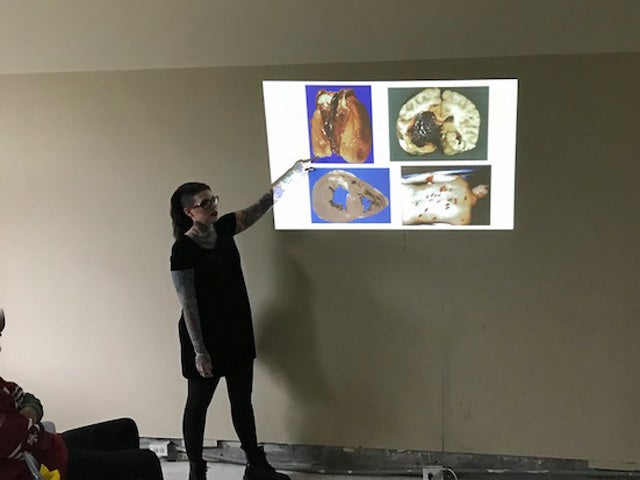Educating about the end of life, with some fun thrown in
The idea of the third annual “Before I Die” festival in Collingswood, New Jersey was to make uncomfortable conversations around death easier.

Pathologist's assistant Nicole Angemi. (Shai Ben-Yaacov/WHYY)
Nicole Angemi flashes a photo of a brain, a pair of lungs, and a dead body. She points at the brain.
“Does anyone have any idea what this is?”
Someone in the crowd mumbles “brain aneurysm.”
“Yes, that’s a stroke,” says the young pathologist assistant — tattoos running down both arms. She goes on to show pictures of stab wounds, cirrhosis, and a pulmonary embolism. The group is transfixed.
The idea of the third annual “Before I Die” festival in Collingswood, New Jersey was to make uncomfortable conversations around death easier, and the lively atmosphere was more reminiscent of the “Day of the Dead” holiday than the sterile silence of a funeral home.
The event was put on by by Samaritan Healthcare and Hospice Partners and the Courier-Post, and hosted by Perkins Center for the Arts in Collingswood.
Karen Chiguones, Executive Director of Perkins, was skeptical at first.
“I thought ‘this is nuts,’” she said.
Samaritan came to her with the idea three years ago, and she was eventually convinced.
“The arts deal with disruption and things that aren’t apparently beautiful and find beauty in them,” said Chiguones. “This experience in addressing death and loss and grief can also engender beauty in the kindness and the courage and the hope that people find in the process.”
“I think it’s a really important topic to talk about before it’s necessary to talk about it,” said Kathy Black of Collingswood. “Sometimes people pass and nobody knows what to do and it’s a really hard time to go through on its own. And if you already have plans in place, it makes it not easier, but a little easier.”
The topic of death doesn’t typically draw a young audience. But attendees ranged in age from early 20’s to late 70’s, and possibly beyond. It helps that just outside the talk, visitors could do face painting, shop for skull jewelry, and watch a potter make urns.
Visitors also got information about end-of-life care, living wills, and life insurance.
WHYY is your source for fact-based, in-depth journalism and information. As a nonprofit organization, we rely on financial support from readers like you. Please give today.




